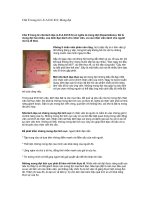Tài liệu Huntington’s Borghese Style Urn as a Study of Two-Dimensional Art & The Production of a Piece of Two-Dimensional Art pptx
Bạn đang xem bản rút gọn của tài liệu. Xem và tải ngay bản đầy đủ của tài liệu tại đây (91.27 KB, 6 trang )
1
The Huntington Library, Art Collections, and Botanical Gardens
I. Introduction
I
n preparation for a school visit to the Huntington’s Art Collections, this lesson will
introduce students to relief sculpture. The Huntington’s reproduction of a Borghese
style urn will be the focus. The relief sculpture lesson is presented with background
information and discussion questions.
II. Objective
♦ To develop and enhance student's awareness of relief sculpture and to have
them discover how this can be used in relaying information about a culture.
III. Background
R
oman style garden urns are “encyclopedias” of information on Roman life,
culture, sports, commerce, and industry. Urns were decorated with either relief
sculptures or drawings and used human figures, animals, and gods as subjects.
Smaller urns were used for everyday use such as for holding fruit or liquid and larger
urns were displayed in elaborate gardens or public gathering places. More elaborate
pieces were given as gifts, placed in tombs, or used as grave markers.
IV. Lesson Activities
Discussion Questions
1. What is sculpture?
2. What does three-dimensional mean? What things are three-dimensional?
RELIEF SCULPTURE IN TWO PARTS
Huntington and Scott Gallery Programs
Grades 4–8
Huntington’s Borghese Style Urn as a Study of Two-Dimensional Art &
The Production of a Piece of Two-Dimensional Art
PART I. HUNTINGTON’S BORGHESE STYLE URN AS A STUDY OF TWO-DIMENSIONAL ART
2
The Huntington
Library, Art Collections, and Botanical Gardens
3. What does two-dimensional mean? What things are two-dimensional?
4. Describe this sculpture. Is it two-dimensional or three-dimensional?
5. Describe the scene on the urn. What are the figures doing?
6. Look at the clothing worn by the figures. How is the clothing different from
today?
7. Some of the figures depicted aren't clothed. Why? If you were the artist what
style of clothing would you sculpt?
8. There is a figure in the scene that seems to be bending over. What do you
think is happening? What is his hand pointing to? Why?
9. Are there any clues in this relief sculpture that indicate why the figures are
assembled?
10. At the top edge of the urn a vine encircles the form. What does this vine
represent? Is it necessary? Why?
11. If you designed a relief sculpture for a Roman style garden urn, what story
would you tell? What would it look like?
Making Connections
1. Have the students read stories about Roman life and compare it to their own
lives. (How is it the same, how is it different)?
2. Discuss ways in which everyday activities relating to sports, culture,
commerce and industry are recorded today (billboards, print ads, television,
radio, etc.), and compare them with how Roman activities could have been
recorded (drawings, two-dimensional and three-dimensional sculpture,
stories, etc.).
3. Guide your students through discussions of myth and mythologies. Compare
the "god-like" qualities of a particular character (such as Diana, goddess of the
hunt) to a modern character (such as Mia Hamm, huntress of a soccer goal).
Huntington & Scott Gallery ProgramsHuntington & Scott Gallery Programs
Huntington & Scott Gallery ProgramsHuntington & Scott Gallery Programs
Huntington & Scott Gallery Programs Relief Sculpture in Two Parts
3
The Huntington Library, Art Collections, and Botanical Gardens
PART II. THE PRODUCTION OF A PIECE OF TWO-DIMENSIONAL ART
I. Objective
♦ To reinforce discussion of relief sculpture.
II. Background
I
n this activity you will use drywall, water and spray bottle, pencils, popsicle
sticks, glue and paint. You will use these items to help students produce a two-
dimensional object—a relief sculpture.
III. Materials Needed
5/8" drywall - 4' x 8' piece cut into 12"x12" pieces or smaller (purchase at a
home improvement store)
drywall knife or x-acto knife
straight edge or ruler
water and spray bottle
crayons
popsicle stick or pencil with the lead tip broken off
glue, hair spray or spray varnish
tempura or water based paints
paintbrushes
IV. Preparation
1. Preparing the drywall for the activity (this should be done by the teacher):
Lay the piece of drywall down on a flat surface. (The top piece of drywall is
the side that tapers down at the edges. It is also the side that has a lighter
color of paper.)
Using a straight edge or by free hand, draw guide lines. Now taking an x-acto
or drywall knife, follow the lines you drew and cut through the paper face of
the drywall. Lift the drywall up and "snap" it against the edge of your work
surface to break it at the line you cut. Turn the drywall over and with the
knife, cut the paper on the underside. Continue the process until you have the
desirable size (12"x12" works well).
Huntington & Scott Gallery ProgramsHuntington & Scott Gallery Programs
Huntington & Scott Gallery ProgramsHuntington & Scott Gallery Programs
Huntington & Scott Gallery Programs Relief Sculpture in Two Parts
4
The Huntington
Library, Art Collections, and Botanical Gardens
2. Before the students begin:
Have the students sketch a few designs, decide which areas will be carved
away and which areas will remain. Next, color in the areas that will be cut
away using a pencil or crayon (some designs that work well are fish, birds,
flowers and trees). Try to keep the designs simple.
V. Procedure
1. Remove the layer of paper from the top side of the drywall (this is the side
that has the lighter color of paper). To do this, spray the surface with water
until the paper peels away easily. The wetter the drywall, the more easily
it will break or crack so use just enough water so that the paper will peel
away easily.
2. Once the paper is removed, have the students copy their design on the
surface of the drywall using a pencil. With crayons or pencil, color the parts
of the design that will remain.
3. Next have the students carve the drywall using a popsicle stick or pencil with
the tip broken off. If the drywall is too hard, soften it by spraying water on it.
4. When the students carve, make sure they don't go too deep because the
drywall will lose its strength in areas that are too thin.
5. When the design is fully carved students can either leave it as is or paint it using
whatever paints are available.
Tips:
To seal the drywall, make a mixture of glue and water (7 oz. white glue, 1 oz.
water) and paint the drywall with the mixture. You can also hair spray or spray
varnish to seal the drywall as well.
The top of a piece of drywall is the side that tapers down at the edges, this
side usually has a lighter colored paper. The bottom of a sheet of drywall
tends to have the manufacturers name stamped on it and there are usually
little holes here and there.
This activity tends to be a bit messy. Use drop cloths or newspaper to aid in
clean up. Any drywall residue on hands, clothes, etc., will wash out with
soap and water.
Huntington & Scott Gallery ProgramsHuntington & Scott Gallery Programs
Huntington & Scott Gallery ProgramsHuntington & Scott Gallery Programs
Huntington & Scott Gallery Programs Relief Sculpture in Two Parts
5
The Huntington Library, Art Collections, and Botanical Gardens
Huntington & Scott Gallery ProgramsHuntington & Scott Gallery Programs
Huntington & Scott Gallery ProgramsHuntington & Scott Gallery Programs
Huntington & Scott Gallery Programs Relief Sculpture in Two Parts
Sculpture Art Lesson
Vocabulary
aesthetic The science of the “beautiful” in a work of art. The aesthetic appeal
of a work of art is defined by the visual. Social, ethical. moral, and
contemporary standards of a society.
armature A structure of wood or wire for example. used under sculptural
materials, such as clay for support.
asymmetry A balance achieved through the use of unequal parts or elements.
Visualize a beach ball sitting on one side of a stick and two baseballs
on the other—balancing out the picture.
balance A principal of art and design concerned with the arrangement of one
or more elements in a work of art so that they appear symmetrical
(even) or asymmetrical (uneven) in design and proportion.
bas-relief A lower relief sculpture that projects only slightly from its two-
dimensional background.
bisque After clay has its first firing in a kiln. it is called bisque ware. At this
stage, the clay has changed composition and can no longer have
water added to it and turned back into useable material.
bronze An alloy of copper and tin used for sculpture.
carving A subtractive method of sculpture that consists of removing stone or
wood from a single block.
casting Plaster mixed with water is poured into a mold. Once it has
hardened it is taken out of the mold as a solid piece of cast sculpture.
ceramic Used to describe the shaping, finishing and firing of clay.
classical Term used to identify Greek art from approximately 500 B.C. to 300
B.C. Sculptural characteristics include a more life-like body, more
natural form with movement, calmness, idealized beauty, and the
appearance of the contrapposto pose.
composition The arrangement of lines, areas, colors and forms.
contrapposto A twist or “S” curve of the human figure caused by placing the
weight of one foot and turning the shoulder.
form Form is an element of art that refers to an object with three
dimensions. A sculpture is three dimensional because it can be seen
from all sides.
6
The Huntington
Library, Art Collections, and Botanical Gardens
glaze A “liquid glass” that is applied to bisqued ware, then fired. The
result is a hard protective coating.
greenware When clav is leather hard. not yet fired. it is called greenware. At
this point, the clay can be made wet and turned back into useable
material.
painting a picture created with paint
kiln A baking oven for clay or metal.
lost wax A method of creating a wax mold of a sculpture and then heating the
mold to melt out the wax and replace it with a molten metal or
plastic.
medium The art material used. i.e.: clay, paint, pencil, bronze, marble.
regionalism art that deals with one specific geographical area
school a group of artists with common interests
myths Stories about Greek and Roman gods and goddesses that explains
and teaches about events, beliefs and natural phenomena.
plaster A powder which when mixed with water will harden into a chalk-
like solid.
proportion In any composition. the mathematical relationship of the parts to
each other and to the whole. For example, the relation of the head
to the body, etc.
shape Geometric shapes look as though they were made with a straight
edge or drawing tool. Square, circle, triangle. rectangle, and oval.
Organic shapes are also called free-form. These shapes are not
regular or even. Their edges are curved or angular, or a combination
of both.
symmetry A balance in which elements are alike. One side “balances out the
other.” Visualize two beach balls sitting on opposite sides of a stick
on the ground.
Huntington & Scott Gallery ProgramsHuntington & Scott Gallery Programs
Huntington & Scott Gallery ProgramsHuntington & Scott Gallery Programs
Huntington & Scott Gallery Programs Relief Sculpture in Two Parts









